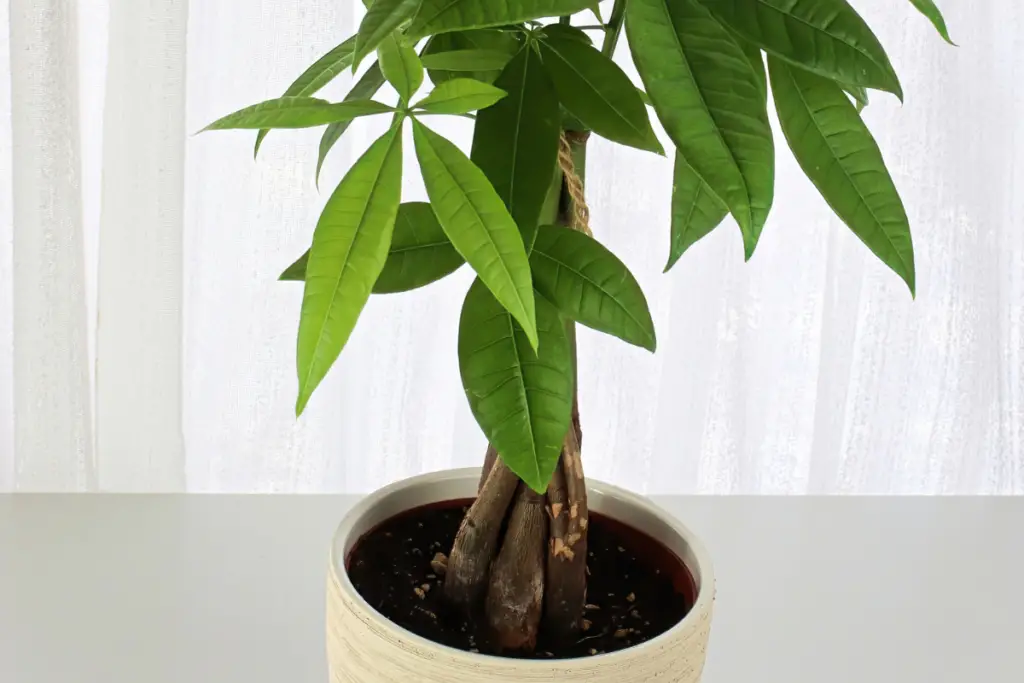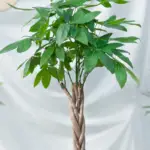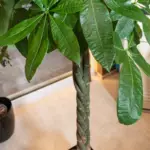Money trees are popular houseplants known for their unique braided trunk and lush green leaves.
These plants are native to Central and South America and are believed to bring good luck and fortune to their owners.
Proper care is essential to ensure that the money tree thrives and remains healthy.
Growing a braided money tree requires a bit of know-how and attention to detail. One of the most important factors is providing the plant with the right amount of water.
Overwatering can lead to root rot, while underwatering can cause the leaves to wilt and turn brown.
Additionally, the money tree needs to be placed in a spot with bright, indirect sunlight and protected from drafts.
With the correct care, braided money trees can grow up to six feet tall and add a touch of greenery to any room.
In this article, we will share some tips and tricks for growing and caring for a braided money tree.
Whether you are a seasoned plant parent or a beginner, these tips will help you keep your money tree healthy and thriving.
From watering to pruning, we will cover everything you need to know to ensure your braided money plant stays lush and vibrant.

Table of Contents
Understanding Money Trees
Origin and Symbolism
The Money Tree, also known as Pachira Aquatica, is native to Central and South America. It is a tropical plant that grows in swamps and marshes.
The plant is also commonly known as the Guiana Chestnut, Malabar Chestnut, or Saba Nut.
The Money Tree has a rich cultural history and is believed to bring good luck, prosperity, and fortune.
According to the principles of Feng Shui, the plant can help attract wealth and abundance when placed in the right spot.
Physical Characteristics
The Money Tree is a small to medium-sized tree that can grow up to 60 feet tall in the wild.
The plant has a distinctive braided trunk and glossy, dark green leaves that can grow up to 12 inches long.
The leaves are compound, with five to nine leaflets arranged in a circular pattern.
The Money Tree produces small, yellow-green flowers that bloom in the spring and summer. The flowers are followed by edible nuts that are about the size of a chestnut.
The nuts have a mild, nutty flavor and are often roasted or boiled before consumption.
Varieties
There are several varieties of Money Trees, each with its own unique characteristics. The most common variety is the Braided Money Tree, which is created by braiding several young plants together to form a single trunk.
Other varieties include the Dwarf Money Tree, which is a smaller version of the plant, and the Giant Money Tree, which can grow up to 60 feet tall.
Money Trees are also available in a variety of pot sizes, from small tabletop plants to large floor plants.
The plant can be grown indoors or outdoors, depending on the climate and growing conditions.
Overall, the Money Tree is a beautiful and unique plant that is easy to care for and adds a touch of elegance to any space.
With proper care and attention, the plant can thrive and bring good luck and prosperity to its owner.
Proper Planting and Repotting
Choosing the Right Pot
When planting or repotting a Money Tree, it’s important to choose a pot that is the right size.
A pot that is too small can restrict the growth of the plant, while a pot that is too large can cause the soil to retain too much moisture, leading to root rot.
As a general rule, choose a pot that is only slightly larger than the current one, with a diameter that is 2-3 inches larger than the root ball.
Soil Requirements
The Money Tree prefers well-draining soil that is rich in nutrients. A general-purpose potting mix that is designed for indoor plants is a good choice.
It’s important to avoid using heavy garden soil or soil that is designed for outdoor use, as these can retain too much moisture and lead to root rot.
Additionally, it’s important to ensure that the soil is slightly acidic, with a pH between 6.0 and 7.5.
Planting Process
To plant a Money Tree, begin by filling the bottom of the pot with a layer of gravel or small stones.
This will help to improve drainage and prevent the roots from sitting in standing water.
Next, add a layer of soil to the pot, making sure to leave enough room for the root ball. Gently remove the plant from its current pot, being careful not to damage the roots.
Place the plant in the new pot, making sure that it is centered and at the same depth as it was in the previous pot.
Fill the pot with soil, making sure to press down lightly to remove any air pockets.
Finally, water the plant thoroughly, making sure that the soil is evenly moist.
Repotting
Money Trees typically need to be repotted every 2-3 years, or when the roots begin to outgrow the current pot.
To repot, follow the same process as planting, but use a pot that is slightly larger than the current one.
It’s important to avoid disturbing the roots too much, as this can cause stress to the plant.
Additionally, it’s important to avoid overwatering the plant after repotting, as this can lead to root rot.
Daily Care Routine
Taking care of a braided money tree requires a consistent daily care routine. This section will cover the essential aspects of daily care, including watering, lighting, temperature, and humidity.
Watering
Watering is one of the most important aspects of caring for a braided money tree.
Overwatering can lead to root rot, while underwatering can cause the leaves to wilt and fall off.
The general rule of thumb is to water the plant when the top 2-3 inches of soil are dry to the touch.
It is essential to water the plant thoroughly until water flows out of the drainage hole at the bottom of the pot.
Be sure to discard any excess water in the saucer to prevent the roots from sitting in standing water. During the winter months, reduce watering frequency as the plant’s growth slows down.
Lighting
Braided money trees require bright to medium indirect sunlight for at least six hours a day. Direct sunlight can scorch the leaves, while too little light can cause the leaves to turn yellow and fall off.
If the plant is not getting enough light, consider moving it to a brighter location or supplementing with artificial light.
Temperature
Braided money trees thrive in temperatures between 60-75 degrees Fahrenheit. Keep the plant away from heat sources and air conditioning vents that can cause the leaves to dry out.
Avoid placing the plant near drafty windows or doors, which can cause temperature fluctuations.
Humidity
Braided money trees prefer average household humidity levels. If the air in your home is dry, consider using a humidifier or placing a tray of water near the plant to increase humidity levels.
Avoid misting the leaves, as this can lead to fungal growth and other issues.
By following these daily care routines, you can ensure that your braided money tree thrives and stays healthy for years to come.
Long Term Maintenance
To ensure the longevity of the Braided Money Tree, it is important to provide long term maintenance.
This includes pruning, fertilizing, and controlling any potential diseases or pests that may arise.
Pruning
Pruning is essential for maintaining the shape and size of the Braided Money Tree.
It is recommended to prune the tree during the spring or summer months, as the plant is actively growing during this time.
Use sharp, clean pruning shears to make clean cuts and avoid damaging the tree.
When pruning, remove any dead or yellowing leaves, as well as any branches that are growing in an undesirable direction.
Be sure to leave some foliage on the tree to allow for photosynthesis and continued growth.
Fertilizing
Fertilizing the Braided Money Tree is important to provide it with the necessary nutrients for growth.
Use a balanced, water-soluble fertilizer every two weeks during the growing season (spring and summer). Reduce fertilization to once a month during the fall and winter months.
Be careful not to over-fertilize the tree, as this can lead to root burn and other issues. Always follow the instructions on the fertilizer packaging and dilute the fertilizer as directed.
Disease and Pest Control
The Braided Money Tree is generally a hardy plant that is resistant to most pests and diseases. However, it is still important to keep an eye out for any potential issues.
If the tree’s leaves begin to yellow or brown, this may be a sign of overwatering or root rot. Reduce watering and ensure that the tree’s soil is well-draining.
If pests such as spider mites or mealybugs are present, use a gentle insecticidal soap to treat the tree.
Be sure to follow the instructions on the product packaging and avoid using harsh chemicals that may harm the tree.
By following these long term maintenance tips, the Braided Money Tree can thrive for years to come.
Braiding Your Money Tree
When to Braid
Braiding a Money Tree is a fun and creative way to add a unique touch to your indoor garden. However, it is important to know when to braid your Money Tree.
The best time to braid your Money Tree is when it is young and has multiple trunks. This will allow you to weave the trunks together and create a beautiful braid.
Once the trunks have become too thick and woody, it will be difficult to braid them together.
How to Braid
Braiding a Money Tree requires patience and a gentle touch. To start, gently weave the trunks of the young Money Tree together, taking care not to break or damage any of the trunks.
Once you have woven the trunks together, use a soft, flexible binding material, such as twine or plant tape, to hold the braid in place.
Be sure not to tie the binding material too tightly, as this can damage the trunks.
Maintaining the Braid
Maintaining the braid of your Money Tree is important to keep it looking healthy and beautiful. As the Money Tree grows, it will continue to thicken and become woody.
It is important to regularly check the binding material and adjust it as necessary to prevent it from cutting into the trunks.
Additionally, it is important to prune the Money Tree regularly to maintain its shape and prevent it from becoming too large.
Overall, braiding a Money Tree can be a fun and rewarding experience. By following these tips, you can create a beautiful and unique addition to your indoor garden.
Troubleshooting Common Problems
Money Trees are generally easy to care for, but they can still experience some common problems. Here are some tips for troubleshooting these issues.
Yellowing Leaves
If the leaves of your Money Tree are turning yellow, it could be due to overwatering, underwatering, or too much direct sunlight.
Check the soil moisture level and adjust your watering schedule accordingly. Make sure the plant is not getting too much direct sunlight, as this can cause scorching of the leaves.
If the plant is in a drafty area, move it to a more stable location.
Dropping Leaves
If your Money Tree is dropping leaves, it could be due to a lack of water or humidity. Check the soil moisture level and adjust your watering schedule accordingly.
If the air in your home is dry, consider using a humidifier to increase the humidity around the plant. If the plant is in a drafty area, move it to a more stable location.
Stunted Growth
If your Money Tree is not growing as quickly as you would like, it could be due to a lack of nutrients or light.
Make sure you are fertilizing the plant regularly with a balanced fertilizer. Rotate the plant every month to ensure even growth.
If the plant is not getting enough light, consider moving it to a brighter location or using a grow light.
Remember that Money Trees are relatively slow-growing, so it may take some time to see significant growth.
With proper care and attention, your Money Tree will thrive and bring good luck and prosperity to your home or office.
Conclusion
Growing a braided money tree is a fun and rewarding experience. With the right care and attention, your plant can thrive for many years to come.
Remember to keep your plant away from direct sunlight, water it regularly, and fertilize it every few months.
In addition to its aesthetic appeal, the braided money tree is also believed to bring good luck and prosperity.
Whether or not you believe in its mystical properties, there’s no denying that this plant is a beautiful addition to any home or office.
If you’re new to plant care, don’t be intimidated by the prospect of growing a braided money tree.
With a little bit of research and patience, you can create a healthy and thriving plant that will bring joy and beauty to your life for years to come.
Remember to keep an eye out for any signs of stress or disease, and don’t hesitate to seek out professional help if you need it.
With the right care and attention, your braided money tree will be a source of pride and joy for many years to come.
- How to Dry Basil Leaves: A Professional Guide
- Is an Avocado a Fruit or Vegetable? Simple Answer and Explanation
- Does Pineapple Have Seeds? Exploring the Anatomy of Pineapples
- Blooming Through Winter: Can I Grow Vegetables Indoors in the Winter?
- What Can You Grow in a Greenhouse All Year Round: A Guide to Year-Round Greenhouse Gardening
- Are Blueberries Blue? Debunking the Myth of Their Color
















